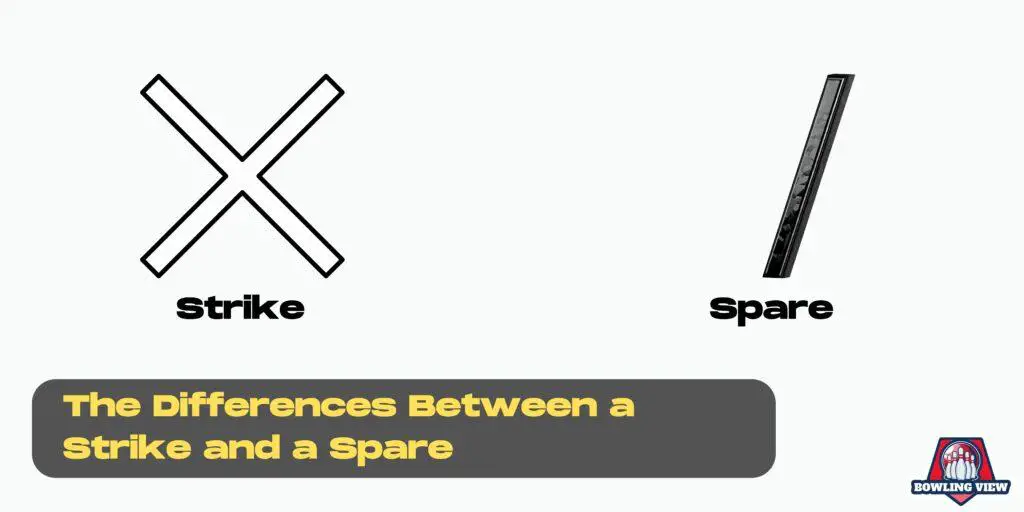Bowling is a loved game by many, young and old, beginners and experts. Even if you’re just starting or a pro in the “American Bowling Congress,” scoring can be confusing.
A big part of that confusion is the term “mark.” So, what’s a mark in bowling? Let’s find out together.
Definition of a Mark
Detailed Explanation of a Mark
In bowling, a “mark” means you knock down all ten pins in one go (one frame). You can do this in one shot, called a strike (we write this as “X”).
Or, you can do it in two shots, called a spare (we write this as “/”). This is the fun part – when you roll the ball, hoping it will hit the right spot and knock down all the pins.
The Differences Between a Strike and a Spare
A strike occurs when the bowler knocks down all 10 pins with their first ball without leaving any standing. This is often referred to as “X”.

A spare, on the other hand, is scored when a bowler uses both their first and second balls in a frame to knock down all 10 pins, marked as “/”. Both of these, a strike or spare, add a mark to your score.
Marks and Their Contribution to Scores
Each mark adds to a bowler’s total score. A strike, the more desirable mark, gives the bowler ten points plus the score of their next two balls.
A spare, meanwhile, gives ten points plus the score of their next ball. This way of counting marks makes bowling a dynamic and exciting game where leads can change quickly.
Importance of Marks
Impact on Game Strategy
Getting a mark in bowling is super important. If you can get marks regularly, you’ll get a high score. It’s not just about hitting all the pins but doing it in a way that gets you the most points.
You need a good plan, like knowing where to aim the ball, how the oil on the lane changes the ball’s path, and picking the right ball for the lane.
Marks Influence on Subsequent Turns
When you get a mark because you made a strike or a spare, it affects your next turns. For example, if you make a strike, you add the points from your next two balls to that strike.
If you keep getting strikes, your points can add up. This is called a “double” for two strikes in a row or a “turkey” for three.
The Role of Marks in Professional Bowling
In professional circles, the American Bowling Congress and USA Bowling League or tournament play, marks play a crucial role in determining the winner.
The perfect score of 300, achievable only by striking in every frame, is every bowler’s dream. But even beyond this, marks are a way of estimating who was ahead at any given point in the game, making them a crucial part of the competitive scene.
Scoring in Bowling
General Overview of the Scoring System
Scoring in bowling is more complex than just counting marks. Each game comprises 10 frames, and in each frame, the bowler has two chances to knock down all 10 pins.
If they knock them all down in the first ball, it’s a strike. If they take two balls to knock them all down, it’s a spare. But if they don’t manage to knock them all down in two tries, they get points for the number of pins knocked down.
How a Strike is Scored
A strike is a bowler’s best friend. Scored as a strike, the bowler gets 10 points plus the total number of pins knocked down in their next two throws. If a bowler can string together a series of strikes, their score can quickly skyrocket.
How a Spare is Scored
Spare is great, but unlike a strike, the bowler scores 10 points plus the number of pins that fall on his first ball in the next frame. So, a spin or strike is the goal of every bowler every time they step on the track and roll the ball.
Scoring Examples with Marks
Consider a simple example. Say, in the first frame, you bowl a strike. In the second frame, you knock down 3 pins with your first ball and 6 with your second.
Your score for the first frame would be 10 (for the strike) plus 3 (your first ball in the second frame) plus 6 (your second ball in the second frame), for a total of 19. The tally up the score continues in this manner throughout the 10 frames.
Strategies to Achieve Marks
Understanding the Lane and Pin Placement
Understanding the bowling lane is crucial to achieving consistent marks. At 60 feet long and with a lane width of just over 3 feet, the lane can seem like a vast expanse when standing at the foul line.
The oil pattern on the lane, the position of the pins, and the way the ball travels along the target line can all influence whether you score a mark or not.
Bowling Techniques
Bowling techniques can significantly affect the ball’s movement and the number of pins that will be knocked down.
From the grip of the bowling ball to the release, from the swing of the bowling arm to the speed of the ball and the axis of rotation, every aspect can be refined to increase the chances of scoring a mark.
Bowling Ball Selection
Choosing the right bowling ball can also play a significant role.
The type of ball, its weight, and how it fits your hand can greatly affect your ability to roll the ball consistently and knock down all the pins.
I wrote a complete guide on how to choose the right ball. Click to read> How to Choose a Bowling Ball
Mental Strategies and Consistency
Finally, mental strategies and consistency are just as important.
Learning to guide the ball, taking dead aim at a target closer or farther down the lane, dealing with the pressure of a tight game, and remaining focused are all skills that must be developed over time.
Famous Bowling Games Involving Significant Marks
Historical Context of These Games
In the history of American Bowling, there have been numerous games where achieving marks was crucial in determining the outcome.
These games are remembered not just for their high scoring but for their dramatic moments when a mark made the difference between winning and losing.
Overview of the Games and Key Moments
Think about the 1970 Championship game. Don Johnson was on a roll with 11 strikes in a row. He was one strike away from a perfect game.
As he got ready to roll his last ball, everyone was silent.
He let the ball go; it went down the lane, and – almost! He knocked down all but one pin, a move known as a “Brooklyn strike.” Even though he missed a perfect game by just one pin, his 11 marks helped him win the title.
Influence on Modern Bowling
These important games have greatly impacted how bowling is played today. They taught us the value of getting marks all the time and changed how bowlers approach the game. It’s not just about hitting the pins anymore. Now, bowlers think about how they aim, hold the ball, let it go, and even what kind of ball they use.
Conclusion
In bowling, whether in a friendly game or a professional American Bowling Congress league match, the mark is king.
From the moment you step over the foul line and take dead aim at the pins to the moment you release the ball and watch it roll down the center of the lane, the goal is to score a mark – a strike or spare.
Bowling isn’t just about knocking down pins – it’s about strategy, technique, and consistency. It’s about understanding the lane, choosing the right ball, and considering every aspect of the game to maximize your chances of scoring a mark.
So next time you’re at the bowling alley, remember, each frame is an opportunity to add a mark to your score, each game a chance to improve, and every strike or spare a step towards a perfect score.


